|
||||||
|
AVENA. Oats and Wild-oats. [Poaceae] |
|
Five or six species of Avena are recorded in Britain. A. fatua x sativa is the only native species. Introduced species include Oat (A. sativa), Slender Oat (A. barbata), Wild-oat (A. fatua), Winter Wild-oat (A. sterilis) and Bristle Oat (A. strigosa). The BSBI provide a downloadable plant crib for Avena. Twenty-one British miners are recorded on Avena. Spencer (1990) recorded the agromyzid Liriomyza orbona on Bellis perennis, although later he stated the host of L. orbona was unconfirmed, but certainly Gramineae (Spencer, 1976). Later still he gives the hosts as Avena, Deschampsia and Poa (Spencer, 1990), although it is not clear whether any of these are British host records. The coleophorid Coleophora lixella is recorded as a seed-feeder on Avena elsewhere. Nearly 100 British miners or possible miners are recorded on grasses in Britain. A key to the European miners recorded on Avena is provided in Bladmineerders van Europa. It is recommended that adults of all miners on grasses be reared to be certain of their identity. |
Key for the identification of the known mines of British |
1# > ? Leaf-mine: Details unknown. |
|
Liriomyza orbona (Meigen, 1830) [Diptera: Agromyzidae]. |
1a > Leaf-miner: Leaf-mine normally short and broad (Spencer, 1976: 97). According to Hering (1957) initially the larva does not feed towards the apex of the leaf. Pupation external (Spencer, 1976: 97). The shallow, whtish mine starts (not very close to the base of the lamina) as a fine ascending corridor. This is overrun when the direction alternates, and the mine quickly widens. The final mine is characteristically short; often not the full width of the leaf is used. Frass in big black grains, never greenish. Pupation outside the mine. |
|
Agromyza ambigua Fallén, 1823 [Diptera: Agromyzidae]. |
1b > Leaf-miner: Larval leaf-mine starts as a narrow channel running towards apex of leaf but later develops into a broad blotch running downwards. Frass largely diffused, giving the mine a characteristic greenish appearance. Pupation external (Spencer, 1976: 126). Corridor, usually several in one leaf, running from close to the leaf base up to near the tip, then reversing direction and widening, resulting in one communal mine in which the larvae descend in a common front. Frass somewhat deliquescent, mine therefore strikingly green. Pupation outside the mine. Neither mine nor larva distinguishable from those of mobilis. Puparium reddish brown |
|
Agromyza nigrella (Rondani, 1875) [Diptera: Agromyzidae]. |
1c > Leaf-miner: The young larva first feeds towards the apex of the leaf, later turning and feeding downwards. Several larvae can occur together in a single leaf. Pupation external (Spencer, 1976: 130). Upper-surface, greenish, gradually widening corridor, at first running towards the leaf tip, then reverses. Through fusion of several mines the final mine is often communal. Frass in backish green grains, often washed out. Pupation outside the mine. Puparium reddish brown |
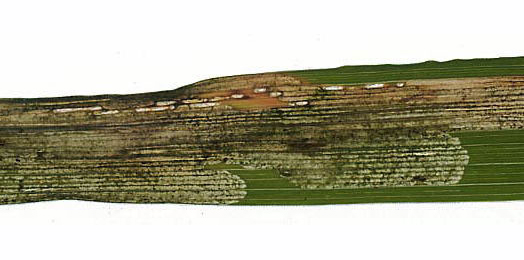 Mine of Agromyza nigrociliata on Arrhenatherum elatius Image: © Willem Ellis (Bladmineerders van Europa) |
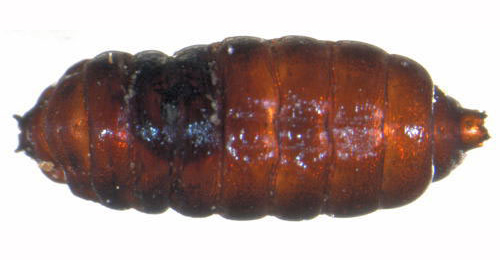 Agromyza nigrociliata puparium Image: © Willem Ellis (Bladmineerders van Europa) |
|
Agromyza nigrociliata Hendel, 1931 [Diptera: Agromyzidae]. |
1d > Leaf-miner: Mine greenish with only single larva, initially running towards apex of leaf before turning back down and developing into a broad blotch. Puparium reddish brown |
|
Agromyza rondensis Strobl, 1900 [Diptera: Agromyzidae]. |
1e > Leaf-miner: Long, narrow, whitish mine. Pupation internal (Spencer, 1976: 453); anterior spiracles projecting through the epidermis. Whitish, upper-surface, rather narrow corridor with comparatively large frass grains that are laying further apart than their diameter. Pupation within the mine. The anterior spiracles of the orange-brown puparium penetrate the epidermis. |
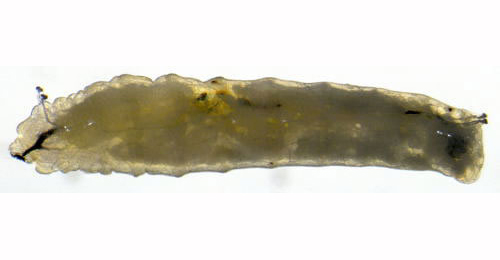 Chromatomyia nigra larva, lateral Image: © Willem Ellis (Bladmineerders van Europa) |
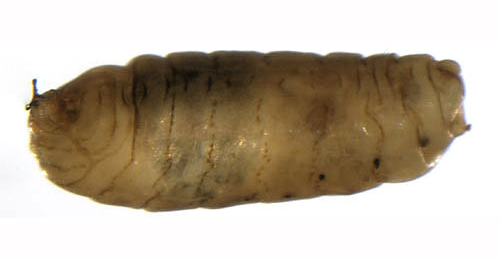 |
| Chromatomyia nigra pupa, lateral Image: © Willem Ellis (Bladmineerders van Europa) |
|
Chromatomyia nigra (Meigen, 1830) [Diptera: Agromyzidae]. |
1f > Leaf-miner: Narrow whitish mine, with frass in distinct black lumps. Pupation internal (Spencer, 1976: 422). Whitish, upper-surface, descending corridor, about halfway up the blade. Frass in distinct black grains that are lying further apart than their diameter. Pupation in the mine. |
|
Chromatomyia fuscula (Zetterstedt, 1838) [Diptera: Agromyzidae]. |
1g > Leaf miner: A substantial linear mine. Pupation internal; posterior spiracles projecting through the epidermis (Spencer, 1976: 449). Elongated, shallow, upper-surface or lower-surface blotch, not infrequently several in one leaf. Frass in strings or pearl chains. Pupation within the mine. |
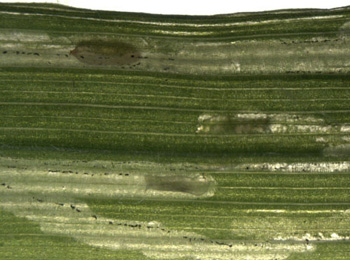 Mine of Chromatomyia milii on Holcus lanatus Image: © Willem Ellis (Bladmineerders van Europa) |
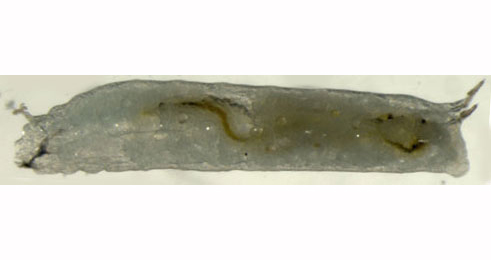 Chromatomyia milii larva, lateral Image: © Willem Ellis (Bladmineerders van Europa) |
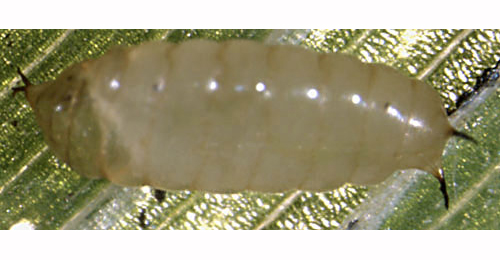 Chromatomyia milii larva, dorsal Image: © Willem Ellis (Bladmineerders van Europa) |
|
Chromatomyia milii (Kaltenbach, 1864) [Diptera: Agromyzidae]. |
1h > Leaf-miner: A short narrow mine, generally near apex of leaf. Larva with each segment bearing a row of characteristic papilli which are retained in the puparium (Spencer, 1976: 328). Pupation internal. Transparent, short and narrow mine not far from the leaf tip. Frass in two rows of grains. Pupation outside the mine. |
|
Pseudonapomyza atra (Meigen, 1830) [Diptera: Agromyzidae]. |
1i > Leaf-miner: Larva feeds mainly in the leaf sheaths. The short mines which may be formed in the leaf blade may be easily overlooked. Pupation internal (Spencer, 1976: 178). Mine begins as a narrow, usually upper-surface, occasionally lower-surface or interparenchymatous corridor in the blade, that descends towards the ligule, thence continues into the leaf sheath, generally on its inside. Usually only one mine per leaf. Puparium in a puparial chamber at the margin of the leaf sheath. Neither mine nor larva can be distinguished from that of C. fulvipes that, as far as is known, only feeds on Poa trivialis. |
|
Cerodontha denticornis (Panzer, 1806) [Diptera: Agromyzidae]. |
1j > Leaf-miner: Broad elongated mine; the form is dependent of the leaf form of the host plant. Frass green. Usually a number of larvae together in a mine. Pupation in the mine. |
|
Cerodontha incisa (Meigen, 1830) [Diptera: Agromyzidae]. |
1k > Leaf-miner: Normally several larvae feed together. Pupation in the mine (Spencer, 1976: 198). Broad elongated blotch. Frass greenish. Larvae generally communal. Pupation within the mine. The black puaria are individially anchored within the mine with a silken thread attached at their rear end. Distinguishable from C. incisa only by means of the larva. |
|
Cerodontha pygmaea (Meigen, 1830) [Diptera: Agromyzidae]. |
1l > Leaf-miner: Upper-surface corridor, generally in the upper half of the blade, running up to the leaf tip, usually occupying more then half the width of the leaf. Frass in green stripes at either side of the corridor. Never more than one larva in a mine. Puparium within the mine, metallic black, not anchered with a string of silk |
|
Cerodontha superciliosa (Zetterstedt, 1860) [Diptera: Agromyzidae]. |
1m > Leaf-miner: A narrow whitish linear mine, running down the leaf from the apex, with frass in two rows of separate grains. Pupation external (Spencer, 1976: 246). Narrow corridor from start to end, whitish, uppper- or lower-surface, genarally running downwards. Mine often along the leaf margin. Frass in distict grains of regular size, alternating along the sides of the corridor. Pupation outside the mine. |
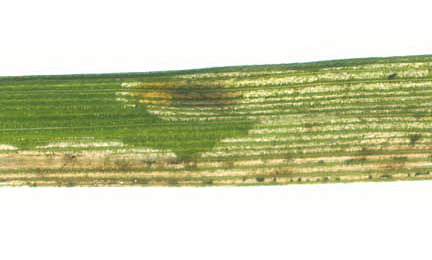 Mine of Liriomyza flaveola on Festuca gigantea Image: © Willis Ellis (Bladmineerders van Europa) |
|
Liriomyza flaveola (Fallén, 1823) [Diptera: Agromyzidae]. |
1n > Leaf-miner: Irregular mine, locally shallow, elsewhere much deeper, giving it a mottled appearance. In broadleaved plants the mine often begins as a blotch with stellate extensions, but sometimes as a very fine, shallow corridor. In grasses the mine often begins in the leaf sheath. The frass is very fine-grained, initially scattered, later in aggregates. |
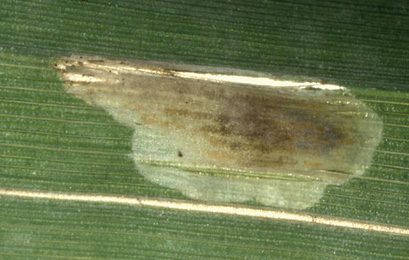 Mine of Hydrellia griseola on Glyceria fluitans Image: © Willem Ellis (Bladmineerders van Europa)) |
|
Hydrellia griseola (Fallén, 1813) [Diptera: Ephydridae]. |
|
Key for the identification of the known mines of British |
Note: The larvae of mining Coleoptera, Hymenoptera and Lepidoptera may live in a corridor mine, a corridor-blotch mine, a blotch mine, a case, a rolled or folded leaf, a tentiform mine or sandwiched between two more or less circular leaf sections in later instars. Larva may pupate in a silk cocoon. The larva may have six legs (although they may be reduced or absent), a head capsule and chewing mouthparts with opposable mandibles (see video of a gracillarid larva feeding). Larvae of Hymenoptera and Lepidoptera usually also have abdominal legs (see examples). Frass, if present, never in two rows. Unless feeding externally from within a case the larva usually vacates the mine by chewing an exit hole. Pupa with visible head appendages, wings and legs which lie in sheaths (see examples). |
1a > Leaf/Stem miner: The larvae mine the stems of various coarse grasses (UKMoths; Plant in Pitkin & Plant, 2005). The larva mines just a few days in the leaf, then continues as a stem borer on the lower part of the stem. They regularly move to a new stem. The central leaves of the infested plants wither and die. |
|
Ochsenheimeria taurella (Denis & Schiffermüller, 1775) [Lepidoptera: Ypsolophidae]. |
1b > Leaf-miner: The larva mines from the grass tip downwards and the mine occupies half or the whole of the leaf blade width. A whitish blotch is formed with characteristic narrow streaks of frass. Full depth blotch, slightly inflated, descending from the leaf tip, occupying half or the entire width of the blade. The larva may move and make a new mine elsewhere. In the latter case the mines are fairly short; otherwise an entire blade may be mined out. Frass in a some narrow greyish brown streaks. Pupation outside the mine. |
|
Elachista albifrontella (Hübner, 1817) [Lepidoptera: Elachistidae]. |
1c > Leaf-miner: Blotch in the leaf tip; the upper side is practically flat, the lower side can turn somewhat to purple. The larva may mine 2-3 leaves. |
|
Elachista bedellella (Sircom, 1848) [Lepidoptera: Elachistidae]. |
1d > Leaf-miner: The mine begins near the leaf tip and descends towards the base. The mine occupies the entire width of the blade. Frass initially scattered, later in an irregular central line. Fully developed mine c. 8 cm long. Probably the larva is capable of leaving its mine and restarting in another leaf. Pupation external. |
|
Elachista pomerana Frey, 1870 [Lepidoptera: Elachistidae]. |
1e > Leaf-miner: Mines downwards from leaf tip to stem. Makes a long narrow yellowish mine. May be up to four larvae in one leaf. Long narrow yellowish corridor, descending from the leaf tip to its base; at times 3-4 larvae in a leaf. Often several larvae in a communal mine. Pupation outside the mine. |
|
Elachista stabilella Stainton, 1858 [Lepidoptera: Elachistidae]. |
1f > Leaf-miner: Narrow, flat, corridor descending from the leaf tip. Frass in an almost continuous line. The larva usually makes several mines. Mines pale yellow green at first, turning purple later. Pupation external. |
|
Elachista subnigrella Douglas, 1853 [Lepidoptera: Elachistidae]. |
| Last updated 01-Jul-2019 Brian Pitkin | ||
